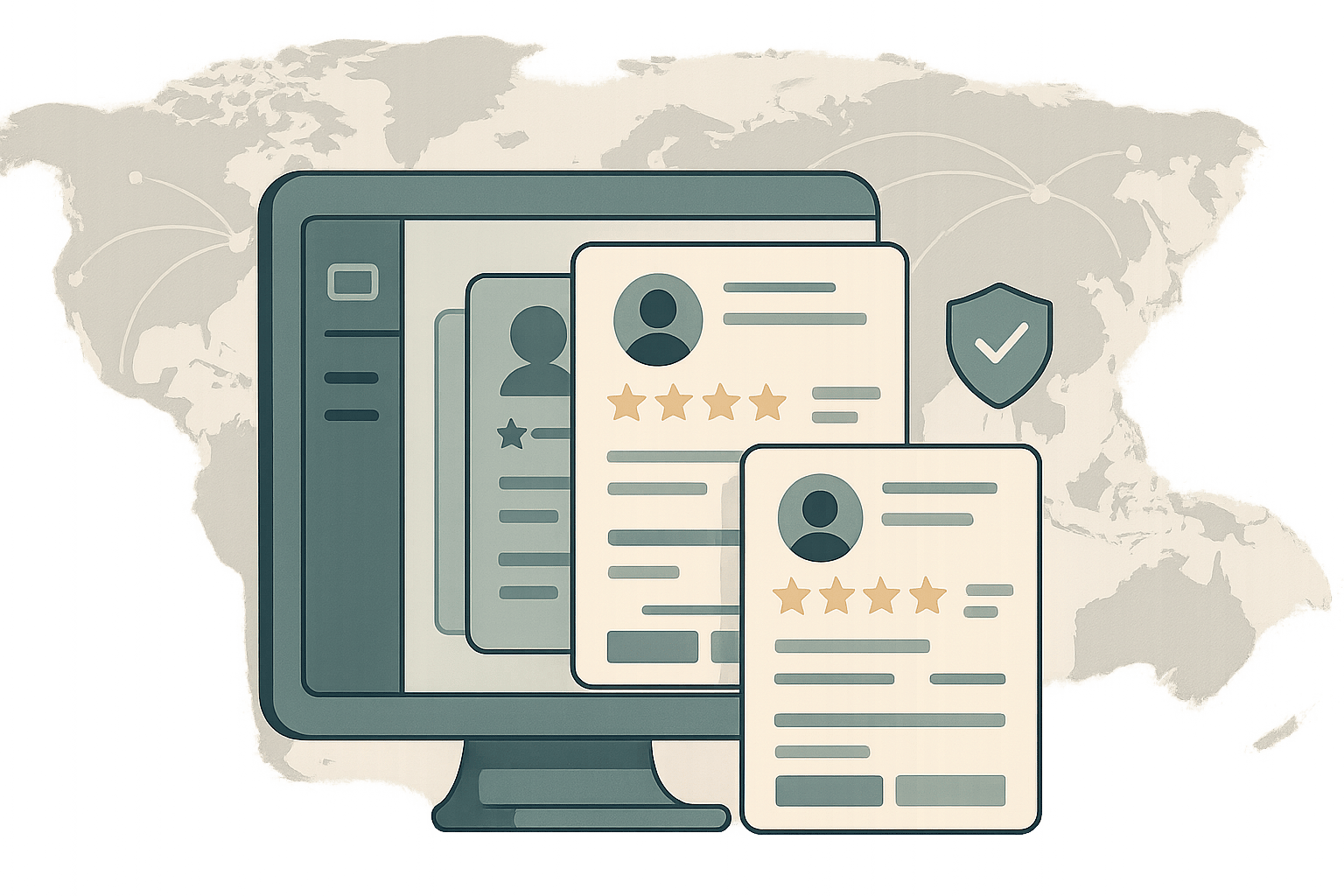Working with Chinese suppliers can be challenging without the right communication strategies. Miscommunication often leads to production errors, shipment delays, and financial losses. To succeed, you need to bridge language gaps, understand business norms, and use the right communication tools.
Key Takeaways:
- Be clear and specific: Use simple language, avoid jargon, and confirm understanding with written summaries.
- Respect business norms: Acknowledge hierarchy, avoid public criticism, and build trust through patience and consistency.
- Choose the right tools: Use email for formal records, WeChat for quick updates, and video calls for complex discussions.
- Build trust: Focus on long-term relationships by being transparent, visiting factories, and maintaining regular contact.
By mastering these techniques, you can reduce errors, build stronger partnerships, and create smoother operations with your suppliers.
Best Mediums for Communicating with Chinese Suppliers
How to Handle Language Barriers
Language barriers can make communication with Chinese suppliers tricky - only about 10% speak English, and even fewer are fluent.
Write in Simple, Clear Language
Keep your communication straightforward. Use plain English, avoiding complex sentences, technical jargon, or idiomatic expressions. This reduces the risk of costly misunderstandings.
For example, instead of saying, "Try to get it done as soon as you can", be specific: "Ship the goods by Friday, Nov. 22". Clear deadlines leave no room for confusion.
Break down instructions into bullet points or numbered lists. For instance, if you’re explaining packaging requirements, create a step-by-step list to simplify the process. Visual aids like photos, annotated sketches, or flowcharts can also clarify your expectations. These are especially useful when discussing product changes or specifications.
Another helpful tip: ask suppliers to repeat key points back to you. This ensures they’ve understood your instructions and gives you a chance to catch any misunderstandings early.
To bridge the language gap even further, use translation tools and bilingual documentation.
Use Translation Tools and Bilingual Documents
Translation tools like Google Translate can be a lifesaver for routine communication. While not perfect, they help decode basic supplier responses and clarify simple queries.
However, for contracts or technical documents, professional translation is worth the investment. Misinterpreting these critical documents could lead to serious production errors or legal issues.
Standardized templates are another great way to minimize miscommunication. Create bilingual templates for purchase orders, quality reports, and shipping instructions. This consistency makes interactions smoother and reduces errors.
Consider translating key materials like product catalogs, technical drawings, and quality control checklists. When suppliers can review these documents in Mandarin, they’re more likely to flag potential issues or ask relevant questions early on.
Combining these tools with written follow-ups ensures mutual understanding.
Confirm Understanding with Written Summaries
Whenever you have verbal discussions - whether over the phone or via video call - always follow up with a written summary. Send an email outlining the key points, decisions, and next steps, such as quantities, specifications, deadlines, and pricing. Ask your supplier to confirm receipt and agreement.
Documenting timelines, specifications, and commitments not only ensures accountability but also provides a clear reference for future orders.
How to Work with Chinese Business Practices
Understanding local business practices is just as important as clear communication when working with Chinese suppliers. Chinese business culture places a strong emphasis on hierarchy, indirect communication, and the concept of "face." Mastering these elements can help you build stronger, more effective relationships. A good starting point is to understand the structured hierarchy that defines many Chinese companies.
Respect Hierarchy and Seniority
In Chinese businesses, hierarchy is deeply ingrained, and respect for titles and seniority is non-negotiable. Identifying key decision-makers and involving senior leaders - even for smaller issues - can ensure your message gets the attention it deserves. For instance, Volkswagen faced delays in finalizing a deal with SAIC Motor in 2015 because they failed to acknowledge senior executives appropriately.
Leadership in many Chinese companies often follows a paternalistic model, where leaders provide clear instructions, and subordinates tend to wait for guidance instead of acting independently. Additionally, age is highly respected, so when in doubt, it’s better to show deference. Alongside hierarchy, another important cultural aspect to navigate is the concept of "saving face."
Understand the Concept of 'Saving Face'
The idea of "face" (Mianzi) is central to Chinese business interactions. Public criticism or direct confrontation can damage relationships, so it’s better to address mistakes privately to avoid embarrassing your business partners.
A notable example of this occurred in 2018 when Tesla publicly criticized its Chinese suppliers for missed deadlines and quality issues. This move strained relationships and highlighted the importance of handling such matters discreetly. On the flip side, helping your counterpart "gain face" by recognizing their expertise or contributions can strengthen your partnership. Keep in mind that indirect communication is common; phrases like "we’ll consider it" or "we’ll think about it" may subtly indicate a negative response.
Use Appropriate Etiquette and Greetings
Proper etiquette can go a long way in building trust. When greeting someone, a slight nod or handshake is appropriate, and business cards should be exchanged with both hands, ensuring the text faces the recipient.
Addressing business partners by their proper titles, such as "Chairman" or "Manager", followed by their family name, is also important. If you’re unsure of their title, using "Mr." or "Ms." is a safe option. Learning a few basic Mandarin phrases, such as "Nǐ hǎo" (hello), "Xièxiè" (thank you), and "Zài jiàn" (goodbye), can further show respect and effort.
If physical business cards aren’t exchanged, connecting via WeChat has become a common practice. This platform allows for seamless electronic contact sharing and ongoing communication, which is essential for maintaining relationships.
Lastly, be prepared for slower, consensus-driven decision-making processes. For example, Uber’s attempt to partner with Didi Chuxing in 2017 fell short partly because they rushed negotiations. Patience and an understanding of this pace are vital to earning trust and building long-term partnerships.
Choosing the Right Communication Channels
Picking the right communication channel is crucial when working with Chinese suppliers. The method you choose can greatly influence how effectively you build and maintain these partnerships. It’s not just about clear language - selecting the right medium and respecting local business practices are equally important.
Common Channels for Supplier Communication
Email is your go-to for formal business exchanges. It’s perfect for sharing contracts, specifications, and other important documents because it creates a clear and professional record. In Chinese business culture, email is often the preferred medium for major negotiations and official correspondence.
WeChat, on the other hand, is indispensable in China. This all-in-one platform is used by about 80% of the population. Suppliers check WeChat frequently throughout the day, making it ideal for quick updates and informal conversations. However, keep in mind that WeChat doesn’t offer end-to-end encryption, which may raise privacy concerns for some Western businesses.
Phone and video calls bring a personal element to your communication. These are especially useful for clarifying complex details, demonstrating products, or fostering stronger relationships. Just make sure to follow up with a written summary to document key points discussed.
Communication Channel Comparison
Here’s a quick breakdown of the strengths and limitations of each channel:
| Channel | Speed | Record Keeping | Best For | Limitations |
|---|---|---|---|---|
| Moderate | Excellent | Contracts, formal negotiations, document sharing | Less immediate; may be overlooked | |
| Very Fast | Limited | Quick updates, daily check-ins, relationship building | Privacy concerns; informal tone | |
| Phone/Video | Immediate | Limited | Complex discussions, relationship building | Time zone challenges; no written record |
| Video Calls | Immediate | Moderate | Product demonstrations, technical explanations | Network issues; scheduling conflicts |
Email is best for formal communications like contracts, technical specifications, and anything that needs to be referenced later. Suppliers generally respond within 24–48 hours on business days, making it a dependable option for non-urgent matters.
WeChat is ideal for quick updates, clarifications, or daily check-ins. Responses are often immediate during business hours, making it a great choice for time-sensitive questions.
Video calls are invaluable when you need to explain intricate details, review product samples, or establish rapport. The visual component can help bridge language gaps and ensure clarity.
The trick is to match the communication channel to your specific needs. Use WeChat for fast updates, but rely on email for formal agreements and documentation. After phone or video calls, always follow up with a written summary via email to ensure everyone is aligned and records are properly maintained.
sbb-itb-633367f
How to Build Trust and Long-Term Relationships
Once you've mastered effective communication, the next step in forming strong supplier partnerships is building trust. In Chinese business culture, relationships, or Guanxi, take precedence over quick transactions. This structured approach to business relationships, combined with an understanding of "face" - a concept tied to dignity and reputation - lays the groundwork for successful collaborations.
Trust doesn’t happen overnight. It develops through transparency, respect, and consistent actions. Chinese suppliers value partners who show reliability and cultural sensitivity from the very beginning.
Be Clear About Goals and Expectations
If you want to build trust quickly, start with transparency. Being upfront about your budget, timeline, and quality expectations helps avoid misunderstandings and shows that you mean business.
Kick off new partnerships by clearly defining your quality standards. Don’t assume that your supplier knows what "high quality" means to your business. Share detailed specifications, provide reference samples, and set measurable benchmarks.
It’s also important to establish realistic timelines and stick to them. Document agreements in writing to ensure accountability on both sides. Be honest about your order volumes and growth plans - suppliers are more likely to offer competitive pricing and prioritize your needs when they see long-term potential. Once everything is clearly laid out, follow through with consistency to reinforce trust.
Show Commitment to Long-Term Partnership
Suppliers value partners who are in it for the long haul. Demonstrating this commitment takes more than words; it requires consistent actions. Regular communication, factory visits, and cultural respect all signal that you’re serious about building a lasting relationship.
Stay in touch with your suppliers even when you don’t have immediate orders. Ask about their business, upcoming holidays, or industry challenges. This personal connection strengthens your Guanxi and keeps you on their radar when opportunities arise.
Visiting factories is another way to show dedication. Meeting decision-makers - not just sales reps - offers valuable insights into their operations, quality control processes, and company culture. It also demonstrates that you’re invested in understanding their business.
Acknowledging Chinese holidays and observing gift-giving traditions is another way to show respect. Even small gestures go a long way in building goodwill. Start with smaller orders to test their capabilities, but clearly communicate your plans for future growth.
When issues arise, address them promptly and constructively. Focus on finding solutions rather than assigning blame. Collaborating to resolve problems not only strengthens your partnership but also improves performance over time.
Once trust is firmly established, consider negotiating long-term contracts. Multi-year agreements provide stability for both you and your supplier, often leading to better pricing and priority service during busy periods.
Investing time and effort into relationship-building pays off in the long run. Suppliers who trust you are more likely to offer better deals, prioritize your orders during peak seasons, and even suggest ways to improve your products or processes.
Using Tools for Supplier Discovery and Communication
When sourcing reliable suppliers from China, finding trustworthy partners and establishing clear communication from the outset is critical. Traditional methods, like browsing supplier directories, often leave you guessing about a supplier's reliability. Thankfully, modern sourcing platforms now offer data-driven insights, helping you make more informed decisions with greater confidence.
The real challenge isn't just locating suppliers - it's identifying those you can trust to communicate effectively. Research shows that 75% of companies encounter at least one major supply chain disruption every year. This makes it essential to use tools that can evaluate and monitor suppliers effectively. These tools not only help pinpoint reliable partners but also lay the groundwork for smooth and productive communication.
As highlighted earlier, miscommunication can lead to significant risks. Leveraging these platforms ensures you're starting from a position of knowledge and clarity.
How ForthSource Simplifies Supplier Communication

ForthSource stands out by aggregating products from major platforms and using an intelligent scoring system to assess suppliers based on pricing, credibility, and real-time data. This means you can bypass brokers and avoid RFQ walls that often create unnecessary communication hurdles. Instead, you gain direct access to supplier product pages, streamlining the entire process.
The platform's scoring system evaluates suppliers on multiple factors, including price competitiveness, data accuracy, and public credibility metrics. This encourages transparency and sets consistent communication standards. Additionally, domain trust metrics help identify legitimate suppliers, saving you time and reducing the risk of misunderstandings. By offering side-by-side comparisons, ForthSource allows you to efficiently evaluate suppliers, ask targeted questions, and compare their responses with ease.
Using ForthSource to Reduce Risks and Build Trust
Once you've identified a reliable supplier, maintaining clear communication and building trust become the next priorities.
Trust begins with access to reliable data about potential partners. ForthSource provides real-time monitoring of supplier performance and risk indicators. Its transparency features include collaboration tools that help streamline communication between your internal team and suppliers. By ensuring everyone on your team has access to the same supplier data, you can present a unified approach in negotiations and maintain consistent messaging.
ForthSource goes a step further with advanced scoring features, incorporating sentiment analysis and legal reports. These insights reveal how other buyers have experienced working with specific suppliers, helping you set realistic expectations and ask the right questions from the very beginning.
The platform's trigger-based system is designed to keep costs under control while ensuring thorough trust analysis. You can start by reviewing basic supplier information and only upgrade to more detailed data for the most promising prospects. This makes your communication efforts more targeted and cost-efficient.
"Effective supply chain risk management is not just about identifying and mitigating risks; it's about creating sustainable systems that can adapt and respond rapidly to disruptions." - Christopher Tang, Distinguished Professor at UCLA Anderson School of Management
"There are numerous instances where companies face downturns or disruptions due to economic or political factors, and their clients often find out too late." - Florin Tufan, CEO
Key Points for Communicating with Chinese Suppliers
Effective communication with Chinese suppliers involves much more than just overcoming language differences. It requires understanding cultural subtleties, fostering genuine relationships, and avoiding a purely transactional mindset. Here’s a streamlined guide to help you navigate these interactions successfully.
To tackle language barriers, keep your communication simple and clear. Use tools like diagrams or photos to illustrate your points, and always confirm mutual understanding with written summaries. While translation tools can be helpful, important negotiations should always involve human verification to avoid costly misunderstandings.
Cultural awareness is equally critical. In Chinese business culture, hierarchy, respect, and preserving "face" (mianzi) - a person's reputation and dignity - are essential concepts. Use proper titles when addressing suppliers, handle disagreements in private, and offer praise publicly to help maintain their standing and build goodwill.
"In China, it is the opposite. You need those strong relationships or else they won't be interested in dealing with you, or might not take the best care of your order".
Choosing the right communication channel can also make a big difference. Use email for formal exchanges, WeChat for quick updates, and phone calls for clarifying complex issues. Always follow up with written confirmation to ensure clarity and accountability.
Building strong relationships, often referred to as "guanxi" (personal connections), is at the heart of Chinese business culture. Taking the time to develop these connections fosters trust and collaboration. Show genuine interest in their culture, highlight the benefits of a long-term partnership, and maintain consistent communication to demonstrate your reliability and commitment.
Trust grows through consistent and patient communication. Chinese suppliers value stability and continuity as these signify dependable income streams. Approach conversations with diplomacy and tact, steering clear of direct confrontations that could strain the relationship. As the saying goes, "Learning is a treasure that follows its owner" - each interaction is an opportunity to deepen your understanding.
Companies that prioritize strong supplier relationships often experience fewer disruptions and better overall supply chain performance. While modern tools can help with supplier discovery, respect, patience, and cultural understanding remain the foundation of lasting partnerships.
FAQs
What are the best ways to overcome language barriers when working with Chinese suppliers?
To work effectively with Chinese suppliers despite language barriers, start by using clear, straightforward language. This helps reduce the risk of misunderstandings. Steer clear of slang or overly technical jargon, and always confirm important details in writing to ensure everyone is on the same page.
If communication still proves difficult, you might want to bring in an interpreter or collaborate with a local sourcing agent who understands both the language and the cultural context. These professionals can be particularly useful during technical discussions or negotiations, where precision is key.
Also, pay attention to cultural etiquette. For example, showing respect for hierarchy and maintaining a polite tone can make a big difference. Investing time in building trust and mutual understanding can help create a strong and productive partnership with your suppliers.
How can I build strong relationships with Chinese suppliers while respecting their cultural norms?
Building strong connections with Chinese suppliers hinges on understanding and respecting key cultural values, particularly guanxi. This concept revolves around trust, mutual respect, and the importance of reciprocity. To nurture these relationships, focus on building personal connections through open and honest communication, engaging in social interactions, and thoughtful gestures like gift-giving. Showing a sincere interest in their culture and traditions can significantly strengthen trust and rapport.
It's also crucial to respect hierarchy and maintain consistency in your business dealings. In Chinese culture, harmony and the pursuit of long-term partnerships are highly valued. Approach negotiations with patience and a spirit of collaboration. By aligning your approach with these principles, you can establish supplier relationships that are not only productive but also enduring.
What are the best communication methods for working with Chinese suppliers, and how can they be used effectively?
How to Communicate Effectively with Chinese Suppliers
When working with Chinese suppliers, selecting the right communication channel can make all the difference. Here’s a breakdown of the most effective options and when to use them:
- WeChat: This is the go-to platform for quick updates, informal chats, and sharing files. Since it’s widely used in China, it’s perfect for everyday communication. Plus, it supports video calls, making it versatile for casual yet efficient interactions.
- Email: When it comes to formal matters like contracts, detailed discussions, or official documentation, email is your best bet. While it’s not the primary tool for daily exchanges, it’s crucial for maintaining a professional record of important agreements and conversations.
- Phone calls or video conferencing: For real-time discussions, negotiations, or building stronger connections, these methods work best. If language barriers arise, translation tools can help ensure smooth communication during these calls.
Using a combination of these channels thoughtfully can help you navigate cultural nuances and keep communication clear and effective, paving the way for stronger partnerships with your suppliers.


